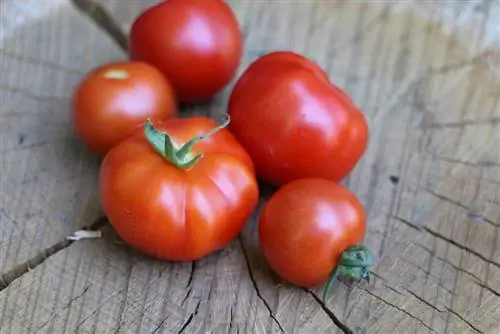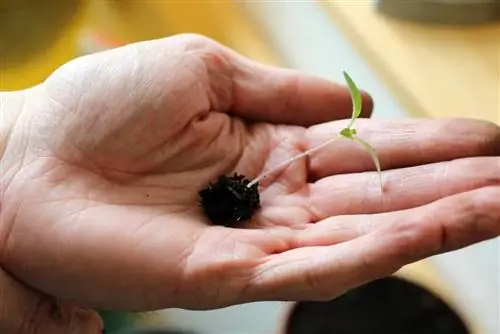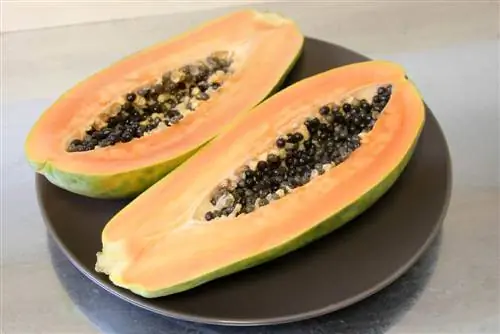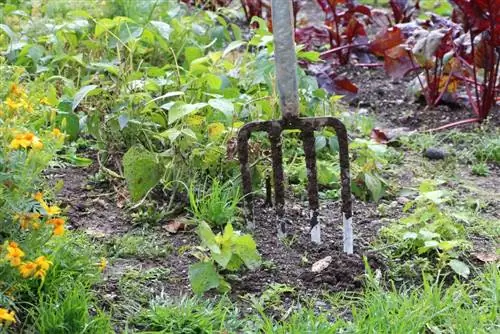- Author admin [email protected].
- Public 2023-12-17 03:39.
- Last modified 2025-01-24 12:45.
The tomato is the queen of the vegetable patch. It gets the sunniest spot, is watered, defrosted and protected from the “bad” rain. The tomato plant is constantly monitored and the ripeness of its fruits is checked. Will it be able to produce lots of red, juicy tomatoes by autumn this time? In the end it says: If the tomato is good, the gardener is also good.
Growth factors
Moisture, light, warmth and time are the elements at work when it comes to success or failure when sowing, regardless of the type of tomato. Not each should be viewed in isolation. Only the combination of all components in the optimal dosage and at the required time creates the suitable growth environment for the tomato. Since not only the gardener but also the unpredictable weather has a hand in it, you always need a pinch of luck so that everything falls into place.
Consistent humidity
Humidity is one of the easiest elements for the gardener to control. However, it requires daily attention. It's less about air humidity than it is about ensuring that the sown seeds don't dry out until they germinate. If the seed dries out in between, no plants will sprout from it. If the seed has already germinated, it is more forgiving.
- the sowing soil must never dry out
- check moisture daily
- water in doses without causing waterlogging
- water with a fine jet of water
- use special watering attachment for rearing
- the irrigation water should be at room temperature
- Clear cover protects against water evaporation
Tip:
A well-rinsed detergent bottle is also good for watering.
Sufficient amount of light
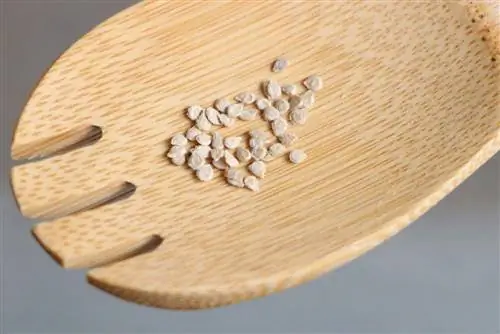
Light is essential and irreplaceable food for plants. Tomato plants will not grow without light. The quality and quantity must be right, i.e. brightness and the duration of exposure to light. In winter the days in Northern Europe are short and the light is weak; towards spring the lighting conditions become more and more optimal. The question arises as to which room or space benefits most from daylight. The following locations are particularly bright:
- Greenhouse
- Winter Garden
- Window sill on the east or south side
- Outdoor bed
Give sowing the brightest spot you can offer. If you don't have a bright enough space, you can create one specifically. Special growth lamps enable seeds to be sown even in dark rooms. The lamps must produce daylight quality of 5,500 to 6,500 Kelvin.
Note:
If the amount of light is not right, the plants “search for it” and grow taller. The thin, soft and flexible stems are an unhe althy growth.
Required heat
Light alone is not enough. No tomato plant will pop its head out of the seed if it is too cold outside. In order for tomato seeds to germinate, they need optimal temperatures throughout.
- 22 degrees Celsius is optimal
- Southwest window is heated by sun
- Caution: Stone and marble window sills bring cold from below
- heat the room additionally if necessary
- Outdoor land is only sufficiently warm from mid-May
- Avoid drafts and prevent cold shocks
- special rearing boxes provide light and warmth
Tip:
An insulating layer of Styrofoam or a small stack of newspaper helps against cold window sills. This way the plants don't get cold feet.
Ideal time
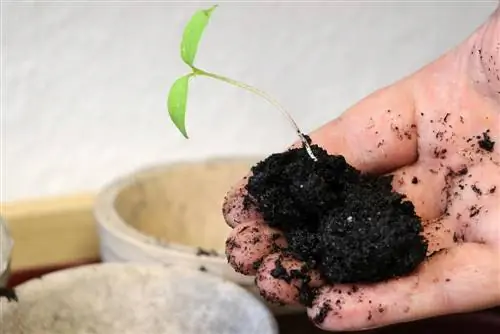
There is simply no fixed time for sowing that is equally suitable for all years. Every year is different. Only afterward does the gardener know whether the timing was right. The general rule is: the earlier you sow, the more time the fruits will have time to ripen later. Too early, however, there is also a risk that the conditions will not remain optimal throughout and growth will be impaired.
Based on the experience gained, time windows have emerged for sowing tomato seeds that have the best chance of success. What matters is where the seeds are sown.
- From mid-February: Heated greenhouse and winter garden
- From mid-March: windowsill
- From mid-May: outdoor bed
Even if you missed the early date, it may well be worth sowing later, until around mid-April. If the conditions are optimal, the plants catch up quickly.
Species and varieties
It all starts with a tiny little seed. And here lies one of the biggest challenges for the tomato gardener. Which seed from hundreds of varieties should it be? Or much more: Which tomato will taste the most delicious? And is it suitable for the given location? Since hardly anyone has enough space to cultivate all varieties, you have to be content with one or a few varieties. It is important to make the right choice of variety. Below is a rough overview:
Romatomaten
They are elongated and egg-shaped and impress with an intense taste. The red fruits have a long shelf life and store well. Good for soups, sauces and ketchup. The Italian bottle tomato 'Corianne' is a well-known representative.
Stick tomatoes
They are the classic with evenly round fruits. They grow tall and need poles for support. Stake tomatoes are very productive. Popular varieties include 'Harzfeuer', 'Vitella' and 'Piccolino'.
Bush or vine tomatoes
They grow low and heavily branched. They deliver their first yields early on. They are suitable for outdoors and for keeping in containers, for example the variety 'Balkonstar'.
beef tomatoes
Round, large and with lots of flesh, beefsteak tomatoes are always. The ratio of sweetness and acidity is balanced and ensures an excellent aroma. Particularly good for pasta sauces. The 'Saint-Pierre' variety is a French classic. 'Ochsenherz' is well suited for outdoor cultivation.
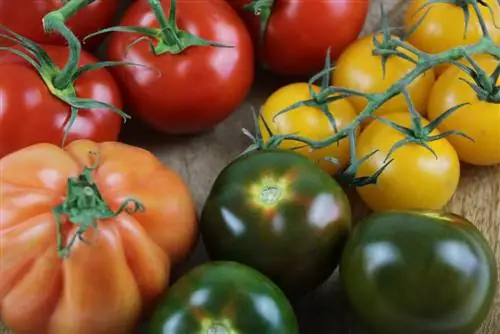
Cocktail tomatoes or cherry tomatoes
Small and sweet as sugar are the characteristics of these types of tomatoes. For salad or as a bite-sized snack between meals. 'Sweet Millon' and 'Cupido'
can also thrive on the balcony.
Wild Tomatoes
If you don't have a garden, you don't have to go without your own tomatoes. Wild tomatoes thrive on balconies or even in rooms. They develop an intense aroma. And the great thing: they are resistant to late blight and brown rot. 'Red Wilde' and 'Yellow Wilde' are well-known varieties.
Old varieties and seed strength
The abundance of fruit colors, shapes and flavors is impressive in the tomato world. It is unfortunate that only a few tasteless “standard tomatoes” find their way onto supermarket shelves. Hybrid varieties may be easy for commercial cultivation, but they are not good for nature or the palate. Not for your wallet either. Because hybrid varieties are not true to seeds. The seeds of their fruits are useless or do not produce the same variety again.
This means for you:
Every year you have to buy new seeds.
If you want to help preserve diversity, you can give an “old variety” a chance. It's also extremely exciting to embark on a new taste adventure. There are even clubs that are dedicated to preserving old varieties and are happy to donate seeds. The advantage of these seeds is their seed strength, so you can continually produce your own seeds from the fruits.
Sowing soil
The seeds must be in the right soil. It must be low in nutrients at the beginning so that the tomato plants can develop their roots well. Special potting soil is available from specialist retailers everywhere. They are also available cheaply in most discount stores just in time for the start of the season.
Growing pots
If the seeds are not sown directly outdoors, you will need suitable cultivation pots or cultivation trays. Special indoor greenhouses with lids are available commercially. They are good, but they also come at a price. However, it is also cheaper. Whether small flower pots, rinsed yogurt cups or even the bottom side of the egg container, many things can be used.
The instructions step by step
The seeds and growing pots are ready, are the conditions right? Then the tomato season can start.
- Fill the container with soil up to 1 cm below the rim.
- Press the soil well.
- Water the soil now, the seeds would be washed away later. It needs to be moist, but not too wet.
- Place the seeds on the soil. The distance between two seeds should be about 2 cm.
- Cover the seeds with just a little soil as they are light germinators.
- Press down the soil and carefully water some more.
- Label the containers so that you will know later which variety is growing there. Pencil works well because it fades least in the sun.
- Now you can put the lid on, alternatively cling film or plastic bag.
- Place the potty in a suitable location. Make sure that the growth factors light, heat and moisture are always present.
- Air the foil occasionally.
The first seedlings can be seen after about 10 days.
If you sow tomato seeds directly into the outdoor bed from mid-May, choose a bed that is well lit by the sun. Foil covering can increase the heat and thus speed up germination, but in sunny weather it can quickly become too hot. Then cover the bed during the day.
Pricking
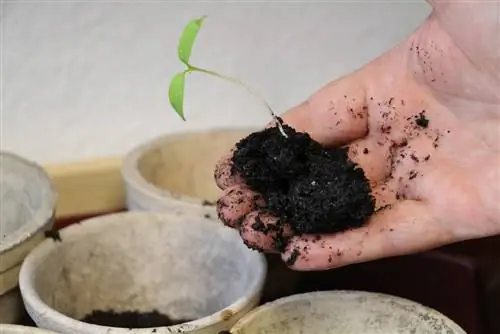
Once the first leaves have developed, the plant needs more space to grow. Her new home should be her own pot, about 9 cm in diameter. Now use regular soil that also contains some nutrients. You can remove the plants from the seed tray using a pricking stick or a household spoon. Be careful not to damage the delicate roots. Depending on how long it takes before moving outdoors, it might make sense to repot it into an even larger pot some time later.
Planting out
From mid-May, after the Ice Saints, the small tomato plants can be planted in the vegetable patch or permanently moved to the balcony in the pot. Don't let warm temperatures entice you to plant earlier. It is important that the temperature does not drop too much at night. If tomatoes suffer a cold shock, this can lead to stunted growth. If there are night frosts, the entire plant freezes.
However, it is possible to put the potty out during the day and bring it back in at night. Make sure that the plants do not get the blazing sun without first slowly getting used to it.
Learn from experience
By autumn at the latest it will be clear whether the time for sowing has been chosen correctly. If you are satisfied with the result, you can do the same in the next gardening year. Otherwise, consider a different time for sowing. Or the time of sowing can be retained if adjustments are possible elsewhere.
- Experiment with other varieties, perhaps they are more suitable.
- Travel on multiple tracks. Tomato seeds are not expensive. Sow several times at intervals and use the strongest plants.
- Do you know a gardener who has harvested plenty of tomatoes? Ask him how he did it and copy him.
- Optimize growing conditions. How about a greenhouse, for example, if the necessary resources and space are available?
Two more tips
Training tomato plants
When people lift weights or do other exercise, their muscles are strengthened. With every challenge more and more. It works exactly the same way with plants. For example, if they are exposed to the wind, their stems become stronger. If tomato seedlings are indoors, then you will become windy! Shake the stems a few times a day, gently with your hand or with a cotton swab. The result is plants that develop better and later produce their first fruits more quickly.
Sowing according to the lunar calendar
The moon affects water, after all there are ebbs and flows. And plants consist largely of water. Maybe the moon believers are right in that they base their sowing on the position of the moon. And if the moon has no effect on the seeds, then it can't do any harm. Waxing moon on a fruit day like Leo, Aries or Sagittarius is said to be ideal.

